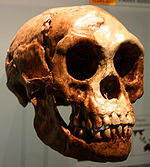Portal:Primates
The Primates Portal A primate is a member of the biological order Primates, the group that contains lemurs, the aye-aye, lorisids, galagos, tarsiers, monkeys, and apes, with the last category including great apes. With the exception of humans, who inhabit every continent on Earth, most primates live in tropical or subtropical regions of the Americas, Africa and Asia. Primates range in size from the 30-gram (1 oz) pygmy mouse lemur to the 200-kilogram (440 lb) mountain gorilla. According to fossil evidence, the primitive ancestors of primates may have existed in the late Cretaceous period around 65 mya (million years ago), and the oldest known primate is the Late Paleocene Plesiadapis, c. 55–58 mya. Molecular clock studies suggest that the primate branch may be even older, originating in the mid-Cretaceous period around 85 mya. Primates exhibit a wide range of characteristics. Some primates do not live primarily in trees, but all species possess adaptations for climbing trees. Locomotion techniques used include leaping from tree to tree, walking on two or four limbs, knuckle-walking, and swinging between branches of trees (known as brachiation). Primates are characterized by their large brains relative to other mammals. These features are most significant in monkeys and apes, and noticeably less so in lorises and lemurs. Many species are sexually dimorphic, which means males and females have different physical traits, including body mass, canine tooth size, and coloration.
Selected article
Babakotia is a medium-sized, extinct genus of lemur, or strepsirrhine primate, from Madagascar that contains a single species, Babakotia radofilai. Together with Palaeopropithecus, Archaeoindris, and Mesopropithecus, it forms the family Palaeopropithecidae, commonly known as the sloth lemurs. The name Babakotia comes from the Malagasy name for the Indri, babakoto, to which it and all other sloth lemurs are closely related. Babakotia radofilai and all other sloth lemurs share many traits with living sloths, demonstrating convergent evolution. It had long forearms, curved digits, and highly mobile hip and ankle joints. Its skull was more heavily built than that of indriids, but not as much as in the larger sloth lemurs. Its dentition is similar to that of all other indriids and sloth lemurs. It lived in the northern part of Madagascar and shared its range with at least two other sloth lemur species, Palaeopropithecus ingens and Mesopropithecus dolichobrachion. Babakotia radofilai was primarily a leaf-eater (folivore), though it also ate fruit and hard seeds. It is known only from subfossil remains and may have died out prior to the arrival of humans on the island, but not enough radiocarbon dating has been done with this species to know for certain.
Selected picture The white-fronted capuchin, Cebus albifrons, is a species of capuchin monkey, a type of New World primate, found in seven different countries in South America: Bolivia, Brazil, Colombia, Venezuela, Ecuador, Peru, and Trinidad and Tobago. The species is divided into several different subspecies, though the specific divisions are uncertain and controversial. CategoriesSelected species Extinct (IUCN 3.1)|Extinct Homo floresiensis ( /flɔːrˈɛziːˌɛn.sɪs/ also known as "Flores Man") is an extinct species of small archaic human that inhabited the island of Flores, Indonesia, until the arrival of modern humans about 50,000 years ago. The remains of an individual who would have stood about 1.1 m (3 ft 7 in) in height were discovered in 2003 at Liang Bua cave. Partial skeletons of at least nine individuals have been recovered, including one complete skull, referred to as "LB1". (Full article...) Did you know?
Primate lists
WikiProjectsThings to do
Associated WikimediaDiscover Wikipedia using portals |

















